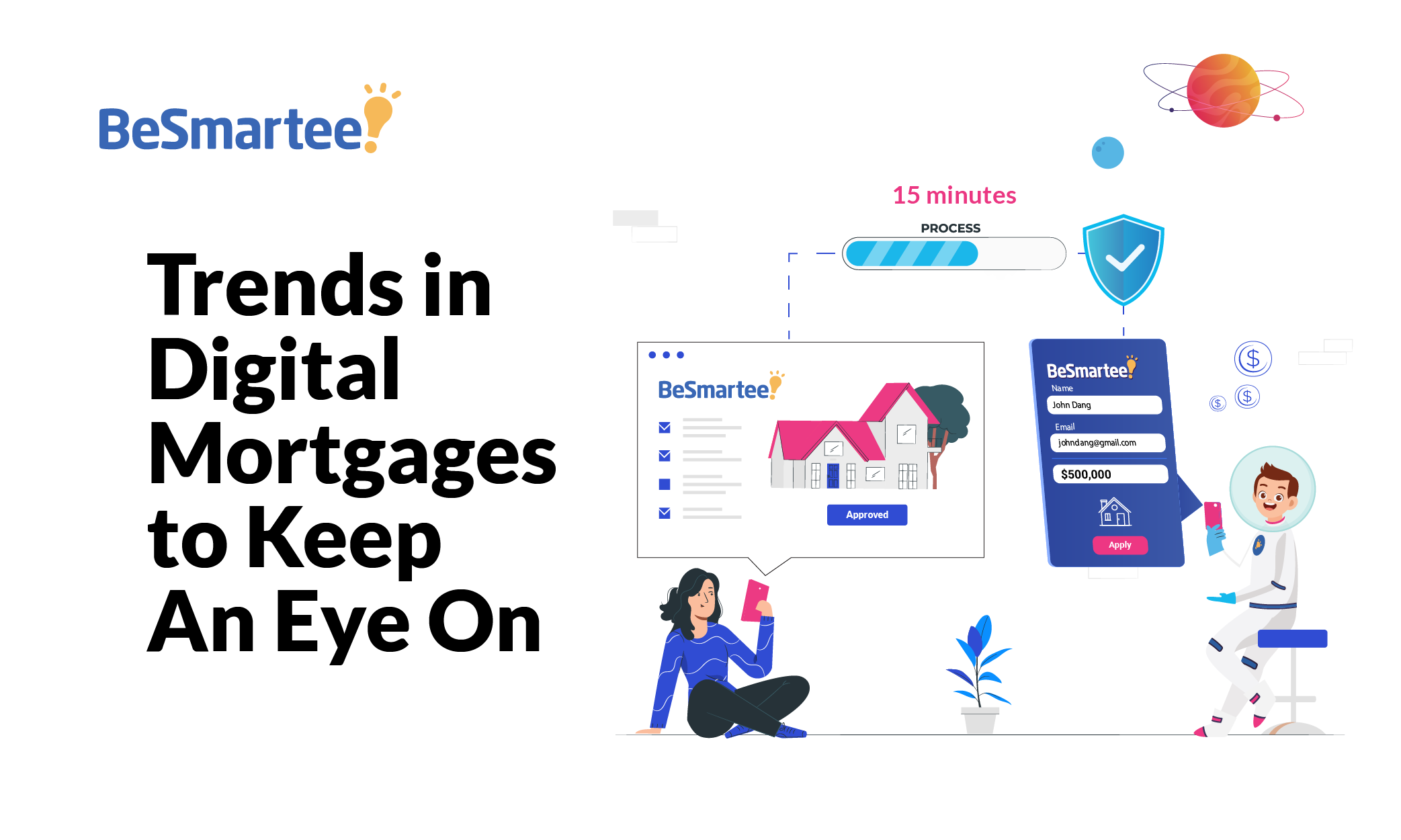Traditional mortgage procedures can no longer sustain consumer demand as the mortgage industry’s digital transformation proceeds at breakneck speed. Lenders are resorting to digital mortgage technologies to stay up with changing client expectations and behaviors. Understanding these customer trends is vital to keep your company in the game.
BeSmartee examines the growing trends affecting the rise of digital mortgages and how they are affecting the lending landscape as a whole.
Digital Mortgages Defined
To understand digital mortgages, it’s first important to understand traditional mortgages. Specifically, the aspects that customers and loan officers alike find frustrating. In the end, everything comes back to time and money. On average, a traditional loan can take well over a month to close, requiring multiple in-person meetings and costs the lender nearly $3,000 to produce a single loan.
Digital mortgages, on the other hand, provide an enormous number of benefits to both lenders and borrowers, in part by reducing the time it takes to complete and cutting the overhead costs for lenders. And when lenders aren’t paying as much to produce the loans, borrowers aren’t paying as much to acquire the loans. It’s basically a win-win scenario for everyone involved.
Digital mortgages can do this by utilizing technology to:
- Facilitate interactions with borrowers
- Automate data input
- Check and compare loan packages
- Run credit checks quickly
- Verify payment methods with banks
- Eliminate the need for customers to ever walk into a loan officer’s office or drop off a sheet of paper
Considered as a whole, switching to a digital mortgage experience can increase profits for lenders and bring down costs for borrowers, pleasing everyone in the process.
Five Important Trends
We’ve talked before about trends within the mortgage industry in relation to digital mortgages, but it’s important to keep track of outward trends from everyday people; the customers looking to purchase their dream home. As customer desires and needs change, so too must lenders adapt their offerings to meet, and hopefully exceed, those expectations. We’ll delve into five rising trends in the following sections.
Trend #1: Constant Updates and Support
Transparency is one of the key desires for modern customers in all of their purchases, but nowhere is it more important than with complicated processes where customers need additional help and education like the mortgage industry. Customers want to know what is happening at every step along the way, and digital mortgages can accommodate that need handily.
Every one of the major stages within the loan should notify the customer. They should receive messages and notifications about signatures needed, credit checks being run and when they should upload certain documents or sign others. However, messages and notifications aren’t enough for most people who aren’t quite clear on the ins and outs of mortgages.

Companies also need to make human interaction more convenient. Allowing instant messaging online, chatbots for basic questions, emails, phone calls and texts; all of these methods of communication make your loan officers and their intimate knowledge of the process more accessible. Customers aren’t cutting loan officers out of the equation; in fact, they want more ways to contact them.
Millennials in particular want to educate themselves about the mortgage process and frequently reach out to loan officers for more than just basic explanations. They want as much information as possible to stay informed about where they are in the process and to help them evaluate the experience as a whole.
Trend #2: Rising Confidence in Digitization
Every generation enjoys teasing the one that came before about their luddite behaviors and lack of technological savvy. Many businesses worried that switching to a completely digital mortgage process could be intimidating for baby boomers and older generations who would prefer traditional mortgages. That might have been true once, but the COVID-19 pandemic has done wonders for improving customers’ confidence in digitization.
Though not what we’d call a silver lining, the pandemic forced everyone to rely much more on technology, especially for communication, than ever before. Since the world continued to turn with jobs, schools and home buying still happening, once-wary people have learned that they can trust digital products and their experiences.
Despite the vaccine rollouts in some countries, new variants and general caution have kept people in the digital purchasing mindset. Customers have spent over a year in various stages of quarantine and purchasing online, so why should they expect anything different for mortgages? Even when the pandemic is no longer a factor, the convenience and expedience of digitization won’t soon be forgotten.
Subscribe to BeSmartee 's Digital Mortgage Blog to receive:
- Mortgage Industry Insights
- Security & Compliance Updates
- Q&A's Featuring Mortgage & Technology Experts
Trend #3: A Cashless Society
Once again, although the pandemic didn’t create the idea of going cashless, the heightened fear of germs and bacteria certainly helped it take off. Where people might have once hesitated with new tap or touchless credit cards, they are now much happier to simply enter their credit information online and skip the entire physical encounter altogether.
While hacks and fraud will never stop being a problem, the decreased amount of cash is seen as increased security for customers who are now leaning more and more towards a cashless society in general. Trusting digital currency is still a big step for many people, but that trust has only increased during the pandemic and younger generations growing up with that trust have few reasons to doubt it.
Digital mortgages can leverage encrypted data and secure customer portals to ensure that everyone’s data and finances are kept safe from the hands of those who might steal.

Trend #4: Mobile Preference
Long before the pandemic, people have been glued to their cellphones. Once smartphones caught on, there was never any excuse to not immediately respond to someone else or to put off doing something. People realize they need something, so they grab their phones and start doing research or buying what they need.
As people become more and more attached to doing business on their smartphones, they’ll expect companies to keep up or get left behind in the shuffle. Digital mortgages work through smartphones by creating convenient customer portals for clients to upload their information and automatically submit digitized forms without needing to reach for anything else.
With the rising preference for mobile buying, it’s all about convenience. Many people work long hours and want to spend their time off relaxing, not schlepping down to a loan office with giant reams of paper and spending hours waiting for a decision. Between trying to schedule a time to come in person and everything else involved, it makes more sense to enable customers to apply for a mortgage from the comfort of their own couches when they’re taking a break from work or a Netflix binge.
Trend #5: Customization to the Max
Finally, digital mortgages can do a lot in the vein of customizing mortgages for individual customer needs. Instead of feeling like just another bank account number, your digital system can thoroughly analyze their situation and provide unique options based on their needs. Customers have changed their behavior and no longer have to rely entirely on one place for their needs.
They want to feel like companies are accommodating them before they’re willing to give them their business. Digital mortgages should offer a variety of options, so customers can have input into their mortgages instead of simply being presented with a single package and told “Take this one.” When customers can pick and choose, they feel heard and like their circumstances matter in the decision.
Clients also want to feel like they are part of the process. While many people will put the majority of their trust in their loan officers when the process becomes complicated, younger generations have proven that they would rather have more information, so they can work with the loan officer and pick from multiple options to customize the package for their needs.

Roundup
Digital mortgage trends aren’t meant to be a panacea for displacing mortgage specialists. Instead, lenders can delegate tedious duties to robots, allowing them to focus on more vital responsibilities like business development, revenue growth and improving the client experience.
Lenders have a variety of alternatives for preparing for when these emerging tendencies become the new normal. So, why not take advantage of the benefits of these digital mortgage technology trends? We guarantee you won’t look back.
Learn why lenders leverage BeSmartee’s mortgage expertise to complete their digital transformations today.




